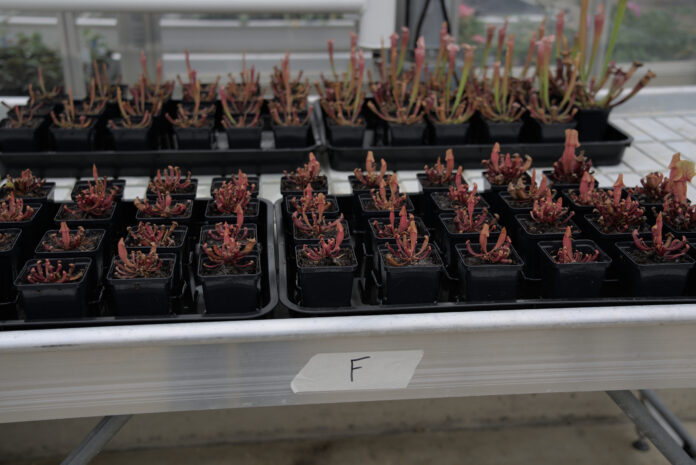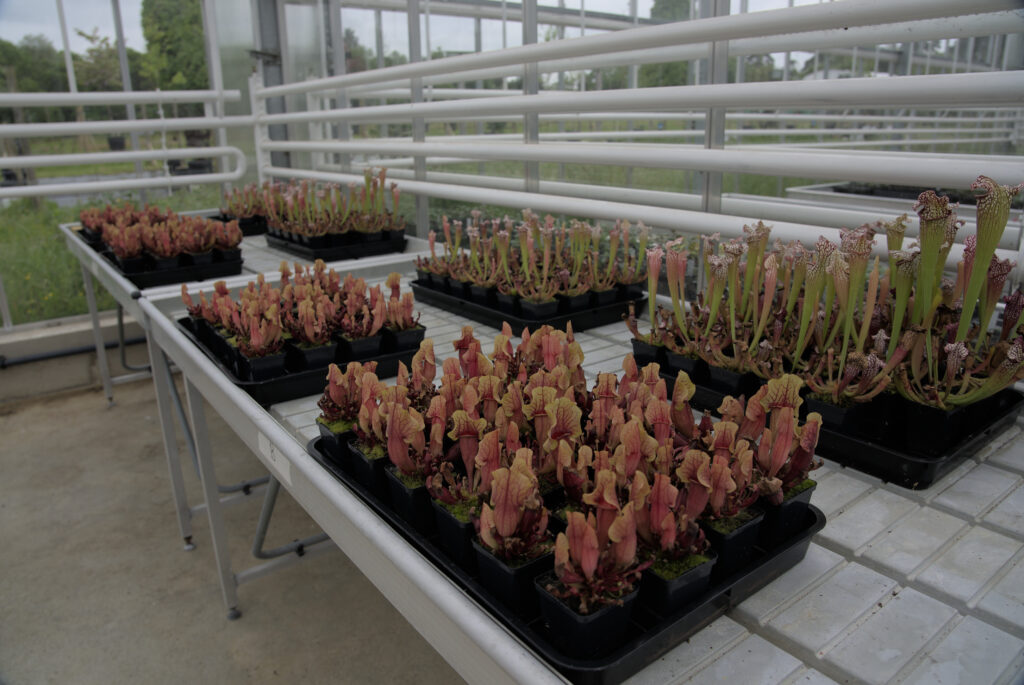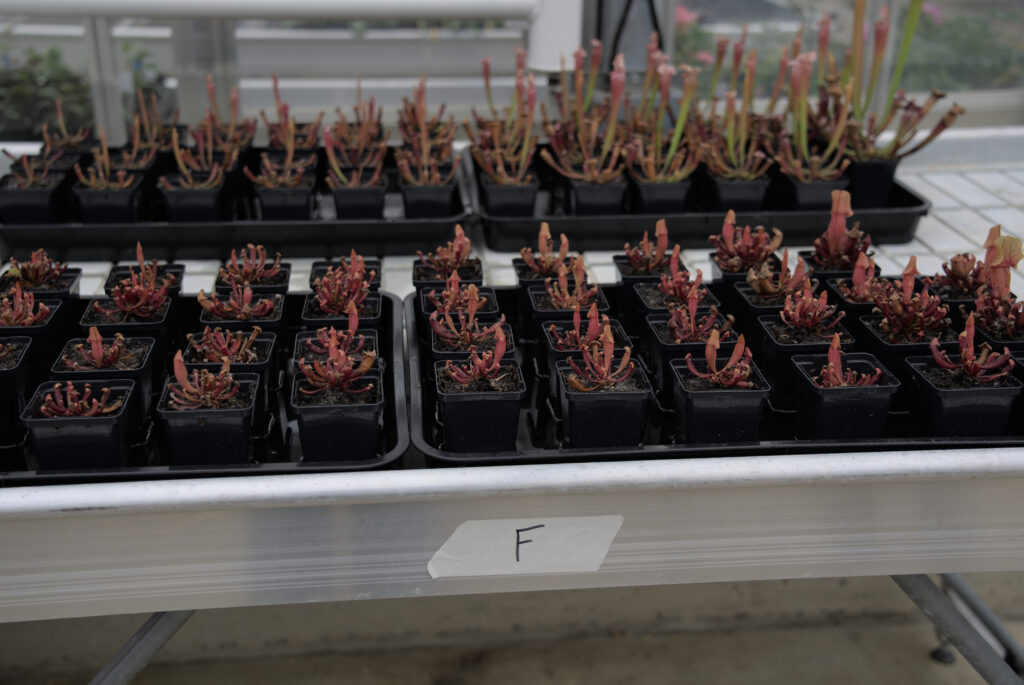


Sarracenia plants grown in various peat-free mixes, left, compared to those grown under identical conditions in peat, right
Scientists from the RHS have successfully grown two popular varieties of carnivorous pitcher plants in five different peat-free growing media, all judged to be superior to the control plants grown in 100% peat.
Carnivorous plants were believed to be one of the most difficult plant groups to grow peat-free as many are found growing in peatland habitats naturally.
The pitcher plants used in the experiment were a Sarracenia leucophylla hybrid and subspecies of Sarracenia purpurea1. These plants have ornate pipes (or pitchers), formed from folded leaves, which they use to trap their animal prey, delivering them supplementary nutrients which are not typically provided by the nutrient-poor soils they grow in. The pitchers on the Sarracenia leucophylla hybrid stand tall, and upright, whereas those of the S. purpurea are shorter and stockier. Both have intricate markings, with the balance of colour between red and shades of green apparently regulated by the choice of growing medium.
The RHS, committed to be 100% peat free by the end of 2025 and to helping the horticulture industry transition away from the use of peat, took on the challenge of growing these specialist plants in alternative materials. RHS scientists, led by Dr Marc Redmile-Gordon, worked with Sean Higgs of Floralive, a carnivorous plant nursery that has grown peat-free since 1990, to demonstrate that high-quality pitcher plants could be successfully grown without peat and to highlight some of the most promising options for peat-free growing media.
Sarracenia plants established from peat-free propagules were grown under identical conditions in six different growing media combinations, including mixes of sustainably-grown sphagnum moss, pine bark and acidified biochar, commercially formulated peat-free media produced by Floralive and a control group grown in peat.
Judges, including carnivorous plant experts Roy Cheek (also a judge at the RHS Chelsea Flower Show) and Mike King, national collection holder for Sarracenias, scored the plants based on their growth and aspects of their appearance (including size, uniformity, colour and attractiveness).
Plants grown in blends of sphagnum and other organic materials were all judged to be vastly superior to those grown in peat, with different peat-free media performing best for each of the two cultivars. In particular, the addition of pine bark benefitted the S. leucophylla hybrid. Roy Cheek was especially impressed by the array of colours on display in the Sarracenia grown without peat.
Professor Alistair Griffiths, RHS Director of Science, said: “This research is a positive step forwards in delivering the RHS Sustainability Climate Positive Target and in the RHS transitioning to peat free by the end of 2025. It is very exciting to see the results from the judging clearly demonstrating that the plants grown in peat were inferior to those grown in alternatives, and that Sarracenia can be grown to the highest standard without peat. Moving away from peat in horticulture has a key role in meeting net zero through protecting and restoring peatlands, turning them from carbon sources to carbon sinks and preventing further loss of these vital habitats. Our research comes at a critical point in the UK’s response to the climate crisis, when it is more important than ever that all possible reductions in emissions are made.”
Sean Higgs, Founder of Floralive, added: “This was a unique and ground-breaking experiment. Thanks to the methodical comparison of peat alternatives at the RHS, these results will be extremely valuable to growers of carnivorous plants worldwide as they transition away from peat.”
The contents of the non-commercial peat-free media mixes will be shared with the public, alongside a grower protocol, so enthusiasts can experiment with creating their own mixes of these promising alternatives to peat to suit the plants they wish to grow. A Floralive peat-free mix is now also available for purchase through the RHS.
Now they have the seal of approval from the judges, some of the peat-free Sarracenia will be planted out at RHS Garden Wisley, while others will be available to purchase at the Wisley Garden Centre. The remainder will be potted on experimentally for continued monitoring and long-term assurance.
To further assist in the RHS journey to peat-free, the garden team at Wisley transferred pitcher plants growing in the alpine display area to peat free mixes composed of composted bark, sphagnum moss, grit and coir fibre, in which they have been thriving, with many currently in flower. A number of Sarracenia are on display, including Sarracenia ‘Vogel’ which has an RHS Award of Garden Merit (AGM) and other carnivorous plants such as the UK native Pinguicula grandiflora.
Following the success of the Sarracenia experiment, the team will now look at growing other popular carnivorous plants without peat, including Venus flytraps (Dionaea muscipula), as well as testing a wider range of ingredient mixes and growing protocols to aid the UK horticulture industry in transitioning profitably away from peat.
To find out more about the ways the RHS is supporting the transition to peat-free horticulture please visit: www.rhs.org.uk/science/articles/rhs-project-to-accelerate-peat-free






